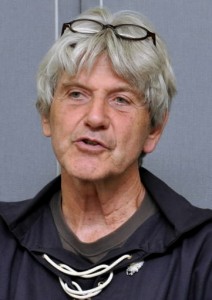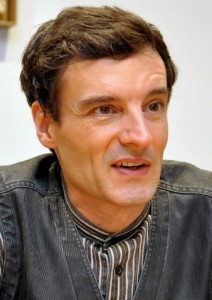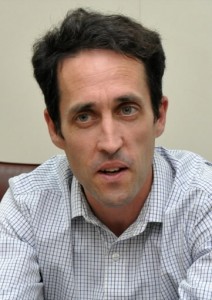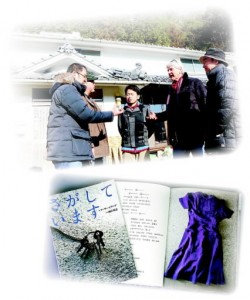Peace Seeds: Teens in Hiroshima Sow Seeds of Peace (Part 21)
Nov. 12, 2015
Part 21: Americans appealing for nuclear abolition realized importance of peace in A-bombed city
Seventy years have passed since the first atomic attack in human history took place. Today, in Hiroshima and in other parts of Japan, not only Japanese citizens but people from the United States, too, the country which dropped the atomic bomb, are calling for the abolition of nuclear weapons.
To end the war, the use of the atomic bombs was unavoidable: This is what students in the United States have been taught about the atomic bombings in school. However, when people come to Hiroshima and see what really happened under the mushroom cloud, they feel differently. By listening to the horrific accounts from A-bomb survivors, and learning how the survivors still suffer from their exposure to the bomb’s radiation, they come to recognize the importance of a world that is free of nuclear weapons.
The junior writers of the Chugoku Shimbun met with three Americans, advocates of nuclear abolition, and listened to their thoughts. We took in not only their views on nuclear weapons but also their feelings on the risks involved in the use of nuclear energy. Following these interviews, we considered what young people can do to help realize a peaceful world, and crafted some suggestions.
Living in A-bombed city brought home the importance of peace
Steven Leeper, 67, former chairperson of the Hiroshima Peace Culture Foundation and now resident of Miyoshi City
I believe peace is of utmost importance. If current conditions persist in the international community, we won’t be able to address environmental issues or the disparity in wealth. The human race will then come to ruin. In order for our species to survive, cooperation from people all over the world is crucial. My ideal is a world where conflicts over ideas can be resolved through dialogue, without resorting to armed force.
I became interested in peace and the atomic bombing when I was living in Hiroshima and frequently listened to talks about the atomic bombing and accounts from A-bomb survivors. As places where nuclear weapons were used for the first time in human history, I think Japan, and Hiroshima and Nagasaki in particular, should be leaders in promoting peace culture and make efforts to raise awareness of these issues among people around the world.
Up to this point, though, only the horror of nuclear weapons and the importance of peace have been communicated from the A-bomb cities. These messages don’t discuss what peace actually is and how we should act to realize a peaceful world.
In Kounu, part of Miyoshi City, I’m creating a Peace Culture Village where peace can be contemplated in a rural setting. With an old farmhouse as the base for the site, people at the Peace Culture Village perform farm work in the fields and live off the land. We’re seeking to create a sustainable community that, to the extent possible, doesn’t rely on artificial energy, like electricity. The goal of this village is for people to reflect on the nature of peace while living together with others from different countries.
I think young people in Hiroshima have become allergic to the word “peace” and don’t want to hear it any more. This is because they haven’t received a good explanation on the real meaning of peace from adults. What “peace” means should be seen from a variety of cultural viewpoints and given greater thought. (Written by Shiori Niitani, 17, and Nanoka Masuda, 16; Photo by Yoshiko Hirata, 14)
Fighting against the fakery of war
Arthur Binard, 48, poet and resident of Naka Ward
I was born when the United States was in the midst of the Vietnam War. Growing up, I was touched by the war and frustrated over how “fake” it was once I began to understand things. Governments justify waging war, but violence and killing should never be seen as positive things.
I think the essence of literature involves pushing back against this frustrating contradiction in society. As a poet, I can’t help but resist the “fake” where words are used as window dressing, creating a gap with reality.
I am often thought of as a peace activist, but I don’t view myself that way. Fighting against the fakery of war through my personal expression has simply led me to take part in peace activities.
Nuclear energy is also fake. Japan is now suffering from serious nuclear damage. Nuclear energy, nuclear development, and the use of the atomic bombs all share the same roots. In my opinion, digging up uranium for these things is a crime against all living creatures on the earth.
People tend to think that nuclear weapons and war are not issues that affect us directly. But no one is removed from all the conflict taking place in the world today. If you say, “It has nothing to do with me,” this means you’re ignoring the history of war experiences, and are disregarding the people and animals that have suffered and lost their lives in these wars. A world full of people who think this way is unacceptable to me.
I hope young people will view the conflicts and hunger occurring in many parts of the world as issues that are relevant to their own lives, instead of simply seeing them as someone else’s problems. This is vital for the future. (Written by Chiaki Yamada, 16; Photo taken by Shiori Niitani, 17)
Hard to understand the continuing use of nuclear energy
Gerald O’Sullivan, 41, teacher at Hiroshima Jogakuin Junior and Senior High School and resident of Asaminami Ward
One thing impressed me when I came to Hiroshima and started working here. It’s the fact that the A-bomb survivors and citizens of Hiroshima have overcome their bitterness and forgiven the United States and its people for dropping the atomic bomb. This was so different, and so surprising, from the impression I had when I was in the United States.
After graduating from college in Chicago, I applied to become an assistant language teacher in Japanese schools. But I wasn’t able to choose where I would work in Japan. Along with others, I said, “As long as it isn’t Hiroshima or Nagasaki, it’s fine.” This was because I had imagined that the people of Hiroshima still held a grudge against Americans.
Back in America, I was taught that the atomic bombing brought the war to an end and saved the lives of many American soldiers. However, after I visited the Peace Memorial Park and the Peace Memorial Museum, I came to understand the inhumanity of nuclear weapons and how the A-bomb survivors are still suffering from the aftereffects of their exposure to the bomb’s radiation. At this point, my outlook began to change and I started thinking that the atomic bombing wasn’t a justified act, after all.
I’m opposed to the use of nuclear energy, too. Despite the risks that are now widely recognized as a result of the accidents at nuclear power plants in Chernobyl, Ukraine, and Fukushima, nuclear energy is still being used in Japan and in the rest of the world. This is hard to understand.
I’ve been taking part in peace activities with students from Hiroshima Jogakuin Junior and Senior High School. This year we were involved in a campaign connected to the Review Conference of the Nuclear Non-proliferation Treaty (NPT), which was held at United Nations Headquarters in New York. We were gathering signatures from high school students to express their opposition to nuclear weapons.
I’d like young people to pay more attention to the suffering experienced by others in the world, beyond Hiroshima, and help come up with ways to address these problems by working together with others of the same generation. Together with young people, I want to explore various perspectives which could serve as a basis for taking action. (Written by Harumi Okada, 16, and Hisashi Iwata, 14; Photo taken by Mei Morimoto, 17)
Four messages from the junior writers
After these three interviews, we discussed the challenges involved in abolishing nuclear weapons, and brought our thoughts together into four messages. We wish to convey these messages to people overseas and other Japanese youth. (Written by Harumi Okada, 16, Chiaki Yamada, 16, Shunichi Kamichoja, 15, and Yoshiko Hirata, 14)
Please pay a visit to Hiroshima
A visit to Hiroshima will make you better aware of the dangers of nuclear weapons. You can learn about the reasons for the atomic bombing and its destructive power by reading books, but you will keenly understand the damage and sorrow the bomb brought to the people of Hiroshima, as well as the horrible harm of radiation exposure, which still causes suffering today, by touring the Peace Memorial Museum and the Peace Memorial Park in person. If enough people can grasp the reality of Hiroshima, eliminating nuclear weapons won’t be nearly as hard.
Young people should take more interest in the world
Young people in their teens and 20s should pay more attention to the issues of the world and consider how these problems can be addressed. A peaceful world can’t be created simply by eliminating nuclear weapons. Hunger and other issues involving food production, environmental issues like global warming, and conflicts stemming from ethnic and religious differences are other factors that prevent the realization of a peaceful world. Young people should show more interest in the wider world because this is our home now and in the future.
Nuclear power plants must be eliminated, too
On the subject of nuclear energy, the three Americans warned, “It doesn’t make sense to use nuclear energy in Japan, which experiences a lot of earthquakes” and “If nuclear power plants continue to operate, there could be far more serious damage in the future.” In Japan, the accident at the nuclear power plant in Fukushima, triggered by a major earthquake in March of 2011, resulted in a leak of radioactive substances, which still has a substantial impact on people’s lives. The use of natural energy sources, like solar energy, should be promoted, and the nation’s nuclear power plants should be eliminated.
Young people must be proactive
In order to realize the large goal of abolishing nuclear weapons, it’s not enough to convey the horror of nuclear arms and the importance of a peaceful world from Hiroshima. We must also be proactive in getting others involved and taking action together to advance nuclear disarmament. The three people we interviewed asked young people in Hiroshima and Nagasaki to take the initiative in this work. The junior writers pledge to be a part of these efforts.
Junior writers’ impressions after the interviews
What struck me most during the interviews was a remark made by Mr. O’Sullivan, who’s a teacher at my school. He said that his view of the atomic bombing changed after coming to Hiroshima. He also said that people in the United States aren’t aware of the inhumane damages caused by the atomic bomb and the fact that the survivors are still suffering from the aftereffects of radiation exposure. If people in the world would learn about these things without turning their eyes away, they could understand that nuclear weapons must be abolished. (Harumi Okada, 16)
It was my first time taking part in an interview as a member of this group. At first, I was worried because I didn’t know how to handle many things. But it all became clear little by little and I was finally able to finish writing the article. Through these interviews, I again felt how important it is for people of my generation to take action to address the abolition of nuclear weapons and other issues in the world. I now feel even more determined.(Shunichi Kamichoja, 15)
These interviews were my first experience at this. I felt really embarrassed and worried because I was wondering how I could continue the dialogue smoothly, which topic I should focus on the most, how I can take notes at the same time, and other things. However, the interviews helped me learn, step by step, when and how I should ask my questions. Our group decided on the theme for this article on our own, though at first the idea wasn’t clear. I also came to understand the challenges involved in conducting interviews without any concrete material beforehand, writing the article, and publishing it in the newspaper. I want to make use of what I learned this time and be involved in more reporting assignments in the future. (Nanoka Masuda, 13)
What is Peace Seeds?
Peace Seeds are the seeds of smiles which can be spread around the world by thinking about peace and the preciousness of life from various viewpoints. To fill this world with flowering smiles, 45 junior writers from the sixth grade of elementary school to the fifth year of high school, choose themes, gather information, and write articles.
(Originally published on November 12, 2015)











